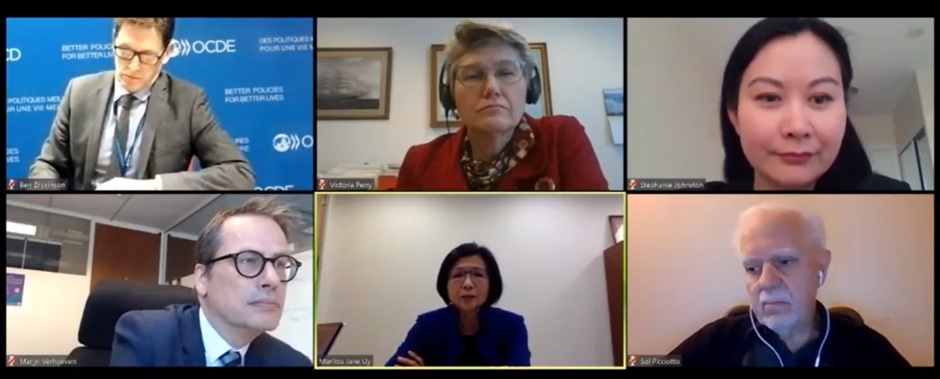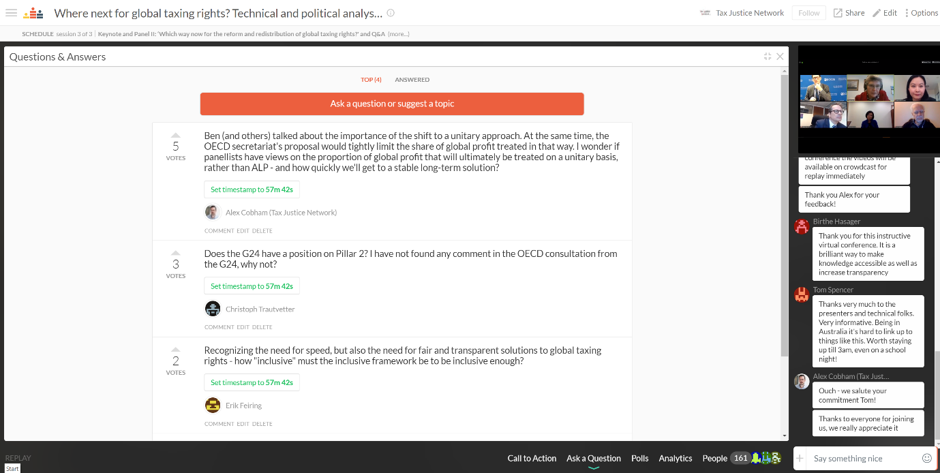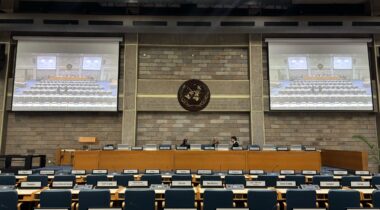
Helena Rose ■ Lessons learned from organising our first virtual conference

In December 2019, the Tax Justice Network held its first virtual conference, bringing together over 150 people from around the world from Portland to Sydney. Offices, living rooms and libraries on different continents were connected into one virtual space where speakers from the OECD, G24, IMF, World Bank and ICRICT discussed leading proposals to reform the international tax system.
Following the conference, we have seen increased recognition of the necessity for such a platform, particularly as governments warn against holding large meetings amidst the Coronavirus outbreak, and organisations begin to take seriously their responsibility to reduce their carbon footprint in order to help tackle the climate crisis.
Our feedback paper and this blog detail some of the findings from our conference, including how to approach planning, the technology used and lessons learned. We hope that this will help other organisations to get to grips with the tools and knowledge needed to move virtual conferences into the mainstream.
Why host a virtual conference?
At the Tax Justice Network, we host a large-scale in-person conference once a year, bringing together hundreds of people to debate key issues on the tax justice agenda. While we recognise that this type of organising is necessary, in-person conferences are hugely time-intensive for our small team and have high overhead costs, leaving us with limited capacity to host essential debates and discussions.
On top of this, we are increasingly concerned about the climate crisis. While it ultimately falls to governments to respond in line with the scale of the calamity that we face, we are committed to making urgent efforts to reduce our carbon footprint. Following the conference, we published a blog estimating the carbon emissions averted by moving our conference online.
Another huge benefit of going virtual is the ability to increase the participation of both delegates and speakers. Removing expensive flights and hotels costs, as well the large time commitment needed to travel, meant that speakers could allocate just a couple of hours in their diary as opposed to an entire week. The demographics of delegates can also change dramatically when a conference is more accessible, and as virtual platforms are scalable, capacity limitations are removed, thereby opening the conference to a much wider global audience.
Below we provide some lessons learned for successful virtual conference planning.
Logistics and planning
Deciding on the date and timing of our conference was a challenge as we needed to be inclusive and give our audience the opportunity to connect from across the world. We settled on the time frame of 13:00 – 17:30 GMT, which meant an early start of 5.30am for participants on the US West coast, while some participants from Australia stayed up until 2.30am to join the conference.
Our session structure was driven by the content, which we split into two halves – the technical aspects of international tax reforms, followed by a wider debate on the political landscape. We opened both halves with keynotes and presentations to set the context of the discussion, followed by panel debates on each topic.
We had around seven weeks to plan our conference, as we wanted to fit in around international events and timelines for tax reforms. This was tight, especially given that it was our first time organising a virtual event, but it proved to be achievable for organising a one-day conference. We used Airtable, Zoom meetings and Slack for the bulk of our virtual planning.
Technology
After trialling many different platforms, we opted for a low-cost combination of Zoom conference call software to host the panel discussions, which were then streamed through OBS: Open Broadcaster Software to the Crowdcast platform.

This setup combined reliability and high-quality calls for the presentations and discussions with the user-friendly interface of the Crowdcast platform, which gives audience members the ability to setup a profile, chat, ask and upvote questions and navigate easily between conference sessions. Feedback on the technology was excellent, and almost all audience members were able to connect and view the conference without any issues – some even noted that they were able to see and hear the content more clearly than if they were at an in-person conference.

Whichever platform you choose, we found that testing the platform with each speaker in advance was essential for a smooth operation on the day, particularly as we had quite large panels and sessions that ran back-to-back, with just 5 or 10 minutes to gather everyone together in the ‘virtual green room’ beforehand. We had all speakers test microphones, webcams, internet connections and presentation sharing in advance of the conference, which was invaluable and meant that all of the speakers were prepared and on time for their sessions.
Session formats and hosting
Working within our limited time window of five hours, which allowed most parts of the globe to connect for at least some of the live conference (sorry Australia!), we broke our content down into three sessions – the opening keynote, a technical panel discussion, and a broader political keynote and discussion.
The host, our CEO Alex Cobham, opened the conference and advised participants in each session on the format and discussions ahead. The feedback on the sessions structure was generally positive, though the first session ran over slightly. To tackle this in future we will opt for briefer presentation sessions where possible so as to allow adequate time for Q&A, separate to panel discussions. The Crowdcast platform can be used to invite audience members on screen to pose questions to the presenter.
Improving networking channels
One commonly stated downside to virtual conferences is the lack of networking opportunities that come from hallway conversations at in-person conferences. To go some way towards addressing this challenge we used Slack channels to share materials with delegates in advance of the conference, with the intention of fostering discussions between staff and recipients and increasing the representation of ideas.
The channels were not used as fully as we had hoped, which we put down to our not dedicating enough resources to this in advance, and not promoting this as often as we should have to foster discussion. This is one area we will be investing further resources in next time around, with more engaging content such as Q&A sessions with speakers to enable debate beforehand.
Other feedback and considerations
There was a consensus that we need to work harder to be more inclusive and represent all parties in the debate, and that we should partner with organisations that are often under-represented in international discussions, particularly those in the global south. In future conferences, we will secure key speakers for the debate earlier in the process, while also looking for ways to support audience members to access stable internet connections to participate in the debates.
What we would do differently next time
Finally, a few things we would do differently next time:
- Get more team members to moderate and engage on the Slack channels, host discussions and promote more widely
- Consider other networking tools on the market
- Look at alternative session formats – keeping them smaller where possible
- Partner with other organisations or ask others to lead panels – particular those in the global south – and secure a wider range of speakers
Read the full paper here, view the conference material here, or get in touch if you would like to share feedback or ideas at: [email protected].
Related articles

Let’s make Elon Musk the world’s richest man this Christmas!

Admin Data for Tax Justice: A New Global Initiative Advancing the Use of Administrative Data for Tax Research

2025: The year tax justice became part of the world’s problem-solving infrastructure

Bled dry: The gendered impact of tax abuse, illicit financial flows and debt in Africa
Bled Dry: How tax abuse, illicit financial flows and debt affect women and girls in Africa
9 December 2025

Indicator deep dive: ‘patent box regimes’

Two negotiations, one crisis: COP30 and the UN tax convention must finally speak to each other

‘Illicit financial flows as a definition is the elephant in the room’ — India at the UN tax negotiations

Taxation as Climate Reparations: Who Should Pay for the Crisis?



Thanks for sharingthis informative article, i really learned new things hopingto read more of your work.
Thank you for your generosity in sharing your experience of online conference organisation. Hugely helpful!